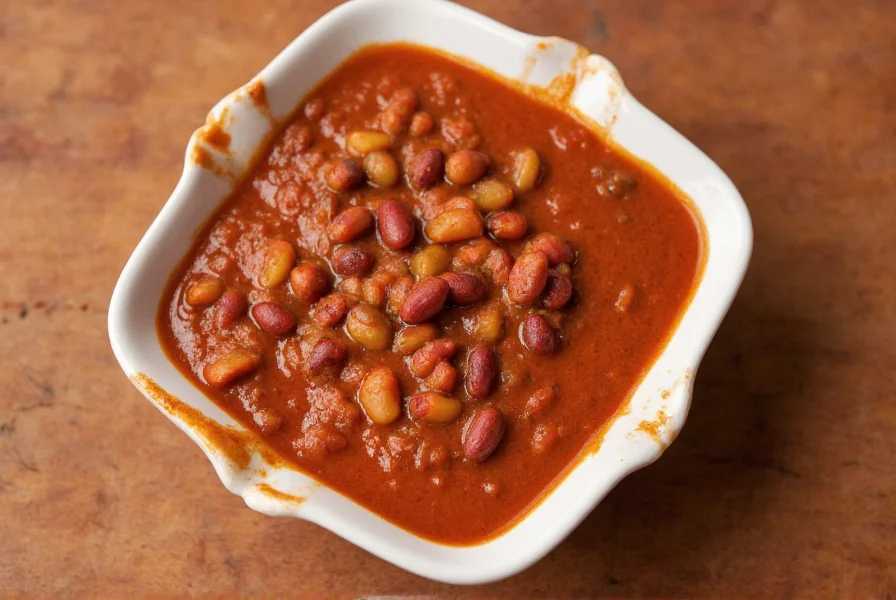Chili con carne has evolved significantly since its origins in 19th century Texas. This beloved dish sparks passionate debates among cooks, particularly regarding the controversial inclusion of beans. Understanding the historical context and practical benefits helps home chefs make informed decisions for their perfect pot of chili.
The Great Chili Bean Debate: History and Regional Perspectives
The question do beans belong in chili divides cooks along regional lines. Traditional Texas chili, often called "bowl of red," typically contains only meat, chilies, and spices—no beans. This style emerged among cowboys who needed portable, protein-rich meals that could cook slowly over campfires.
However, as chili spread across America, home cooks adapted the recipe to include locally available ingredients. In the Southwest and Midwest, beans in chili recipes became standard. The 1951 publication of the San Antonio Chili Stand Cookbook cemented beans as acceptable in many regional variations.
Best Beans for Chili: Varieties and Preparation
When incorporating beans into your chili, selecting the right variety matters. Each type contributes unique texture and flavor absorption properties:
| Bean Type | Flavor Profile | Texture When Cooked | Best For |
|---|---|---|---|
| Kidney Beans | Earthy, robust | Firm, holds shape | Classic Texas-style chili variations |
| Pinto Beans | Mild, nutty | Creamy when mashed | Southwestern and Mexican-inspired chili |
| Black Beans | Sweet, earthy | Firm yet creamy | Cajun or fusion chili recipes |
| Great Northern | Delicate, mild | Very tender | White chili or lighter variations |
For optimal results, soaking dried beans overnight reduces cooking time and improves digestibility. Canned beans offer convenience but require thorough rinsing to remove excess sodium and the starchy liquid that can cloud your chili.

When to Add Beans to Chili: Timing Matters
The timing of bean incorporation affects both texture and flavor integration. Many experienced cooks recommend adding beans during the final 30-45 minutes of cooking. This approach prevents overcooking while allowing sufficient time for flavors to meld.
For authentic bean chili texture, consider partially mashing some beans before adding them to the pot. This technique releases starches that naturally thicken the chili without requiring additional thickeners.
Nutritional Benefits of Beans in Chili
Including beans transforms chili from a meat-centric dish to a more balanced meal. A single cup of cooked beans adds approximately:
- 15 grams of plant-based protein
- 10-15 grams of dietary fiber
- Essential minerals like iron, magnesium, and potassium
- Complex carbohydrates for sustained energy
These nutritional advantages make chili with beans recipe options particularly valuable for vegetarians, budget-conscious families, and those seeking heart-healthy meals. The fiber content also helps balance the richness of meat-based chili preparations.
Perfecting Your Bean Chili: Pro Tips
Follow these expert techniques to elevate your bean chili from ordinary to exceptional:
- Toast dried beans briefly in the pot before adding liquid to enhance nutty flavors
- Add a strip of kombu seaweed while cooking beans to improve digestibility
- Use bean cooking liquid (aquafaba) as part of your chili broth for deeper flavor
- Finish with fresh lime juice to brighten earthy bean flavors
- Let chili rest overnight—the best chili with beans always tastes better the next day

Addressing Common Bean Chili Challenges
Home cooks often encounter these issues when preparing chili with beans:
Problem: Beans remain hard after long cooking
Solution: Older beans may require longer cooking; add 1/4 teaspoon baking soda to the cooking water to help soften them
Problem: Chili becomes too thick with beans
Solution: Reserve some bean cooking liquid or broth to adjust consistency as needed
Problem: Beans break down too much
Solution: Add beans later in the cooking process and avoid vigorous boiling
Conclusion: Embrace Your Personal Chili Style
The question of whether to include beans in chili ultimately comes down to personal preference and intended purpose. For competition chili, follow specific guidelines; for family meals, prioritize what your household enjoys. Modern chili making celebrates diversity—whether you prefer traditional Texas chili without beans or a hearty three-bean version, authenticity lies in the care you put into preparation.
Experiment with different bean varieties and cooking techniques to discover your signature style. The beauty of chili lies in its adaptability—each pot tells a story of the cook who made it.
Frequently Asked Questions
Can I use canned beans instead of dried beans in chili?
Yes, canned beans work well in chili for convenience. Drain and rinse them thoroughly to remove excess sodium and the starchy liquid that can cloud your chili. Add canned beans during the last 30 minutes of cooking to prevent them from becoming mushy.
Why do some chili recipes omit beans?
Traditional Texas-style chili often omits beans because early versions were made by cowboys who needed portable, meat-focused meals. Beans weren't readily available on cattle drives. Some chili competitions also prohibit beans to maintain focus on the meat and chili pepper flavors.
How do I prevent beans from getting mushy in chili?
Add beans during the final 30-45 minutes of cooking rather than at the beginning. If using dried beans, cook them separately until just tender before adding to the chili. Avoid vigorous boiling once beans are incorporated, and consider partially mashing some beans to naturally thicken the chili without overcooking all the beans.
What's the best bean variety for vegetarian chili?
For vegetarian chili, a combination of black beans and pinto beans works exceptionally well. Black beans provide firm texture and earthy flavor, while pinto beans offer creaminess that helps mimic the mouthfeel of meat-based chili. Kidney beans also work well but have a stronger flavor that may dominate other ingredients.
Does adding beans affect chili's shelf life?
Properly stored chili with beans maintains similar shelf life to bean-free chili—3-4 days in the refrigerator or up to 6 months frozen. The key is cooling the chili quickly after cooking and storing it in airtight containers. Beans don't significantly impact preservation when handled correctly.











 浙公网安备
33010002000092号
浙公网安备
33010002000092号 浙B2-20120091-4
浙B2-20120091-4